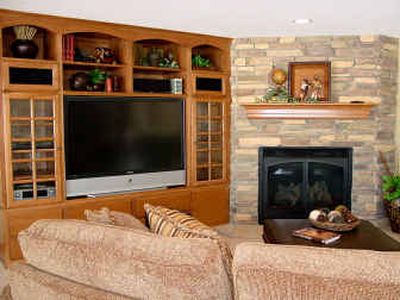SET IN STONE

KANSAS CITY, Mo. — Remodeling an outdated fireplace with natural stone once was a hassle.
For starters, it meant cutting through floor joists and building a new support system to hold up the additional weight of thick, also called full, veneer – about 50 pounds per square foot. That led to nearly rebuilding the entire fireplace.
But now thin natural stone and brick veneers that weigh only 15 pounds per square foot are available for interior face-lifts. This means simply covering what already exists.
Kimberly Robinett is using thin limestone in the 60-year-old Westwood, Kan., home she and her husband, Trent, are overhauling. Rough stones arranged in a low arch frame the cooktop in the kitchen. The veneer also covers the face of the fireplace in the family room.
“It can be manipulated like real rock and cut for size,” says Kimberly, an electrical engineer and co-owner of ACT Real Estate. “You can’t do that with manmade stone.”
The Robinetts plan to use thin brick for the wine bar they’re building near the kitchen. The thin products are attractive and, even though they are expensive, will save the cost of foundation work, Kimberly says.
Thin stone and brick come in the same colors and patterns of full-scale building materials because they are svelter versions of the natural products. Special diamond-blade saws cut stones about 3/4 inch thick (wall stone is typically 8 inches) and bricks 1/2 inch (brick is usually 4 inches), says Terry LeSage, spokesman for Sturgis Materials, a Kansas City, Kan., stone supply business that recently started carrying thin veneers.
Companies, such as Robinson Brick of Colorado and Buechel Stone Corp. of Wisconsin, are expanding their production of the thin natural products. “There’s a lot of growth and interest,” says Scott Watson, manager of Midwest Block & Brick in Shawnee, Kan. “I think a lot of people gravitate to the stone more than the brick.”
This winter Bill and Cathy Hughes of Lake Quivira, Kan., spent about $2,400 on thin stone to cover the wall of white painted bricks that surrounds the fireplace in their family room.
“We didn’t have to tear out a thing,” Bill says. “It was dated before, but now it cozies up the room.”
Thin veneers also are used to enhance facades, chimneys and outdoor kitchens. So far, people haven’t had any problems with the exterior use of thin products except sandstone, Le Sage says. The porous material absorbs water, popping out pieces after a freeze-thaw cycle.
Masons like working with the thin product and are using it more often in new construction.
“When you’re up on scaffolding a few stories high, you would rather have the lighter product,” says Dan Brotherton, owner of Brotherton Masonry in Oak Grove, Mo. “And you’d rather use it than manufactured stone—I don’t like laying fake.”
Lorie and Bill Endsley sought real stone for the facade of the house they were building last year in Overland Park, Kan. To them, manmade stone looked too smooth – and fake.
“I love the fossil imprints on the natural stone,” Lorie says. “It’s more expensive, but it’s worth it.”